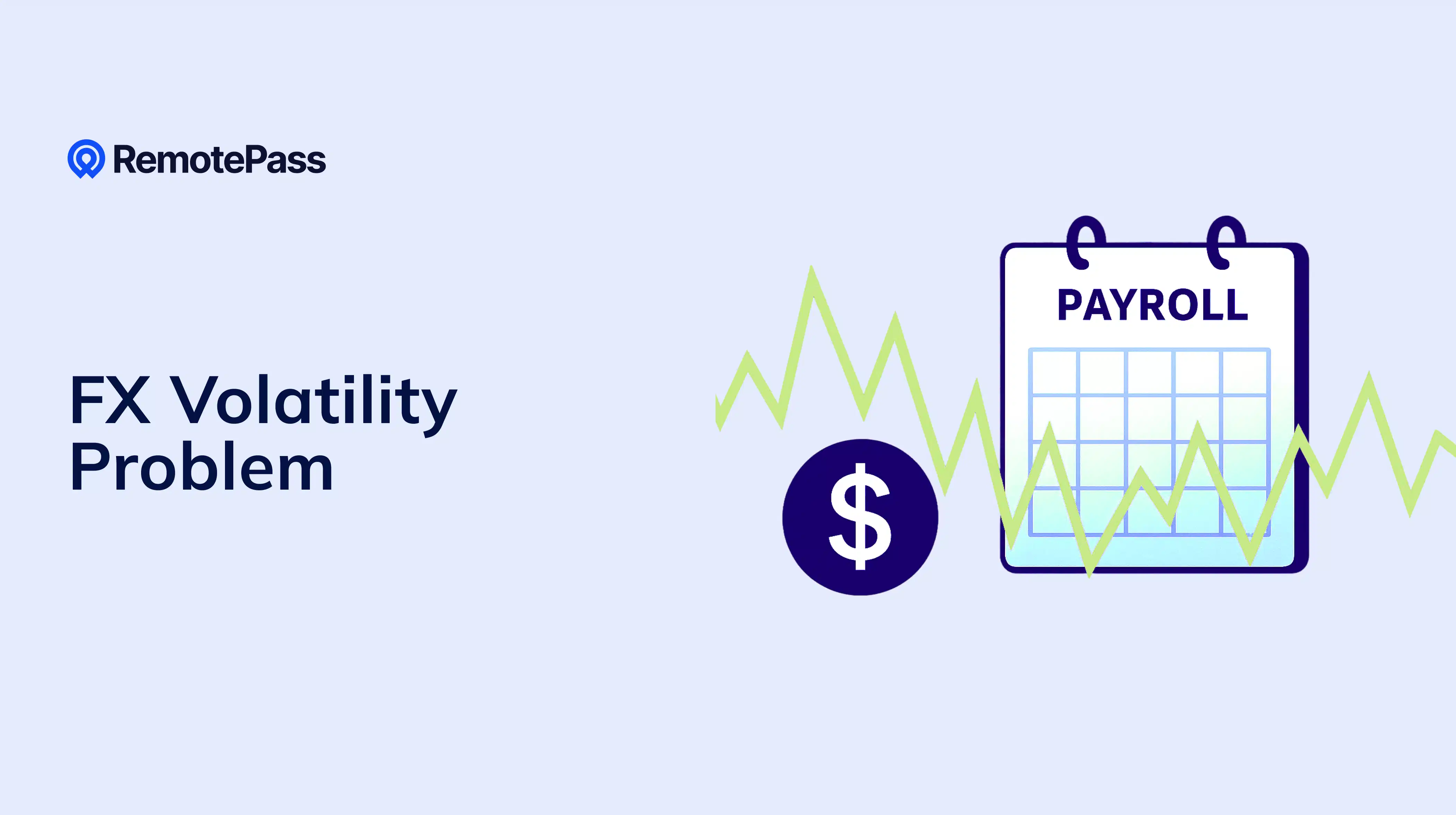
Managing global teams across borders feels exciting until FX volatility knocks your payroll off balance. Suddenly, you’re staring at unexpected losses and cash flow gaps you didn’t plan for.
For finance leaders, the ripple effects add up fast: higher operating costs, payroll systems scrambling to keep pace, employees losing trust when payouts shrink, and finance heads stretched thin trying to explain the numbers.
If you’re anywhere on this chain, this article will help you clearly understand:
- FX risk in payroll and why it matters
- Proven risk mitigation tactics
- How and when to lock FX rates
- How RemotePass simplifies it all
But let’s start with the big question:
Why is FX a Hidden Risk In Global Payroll?
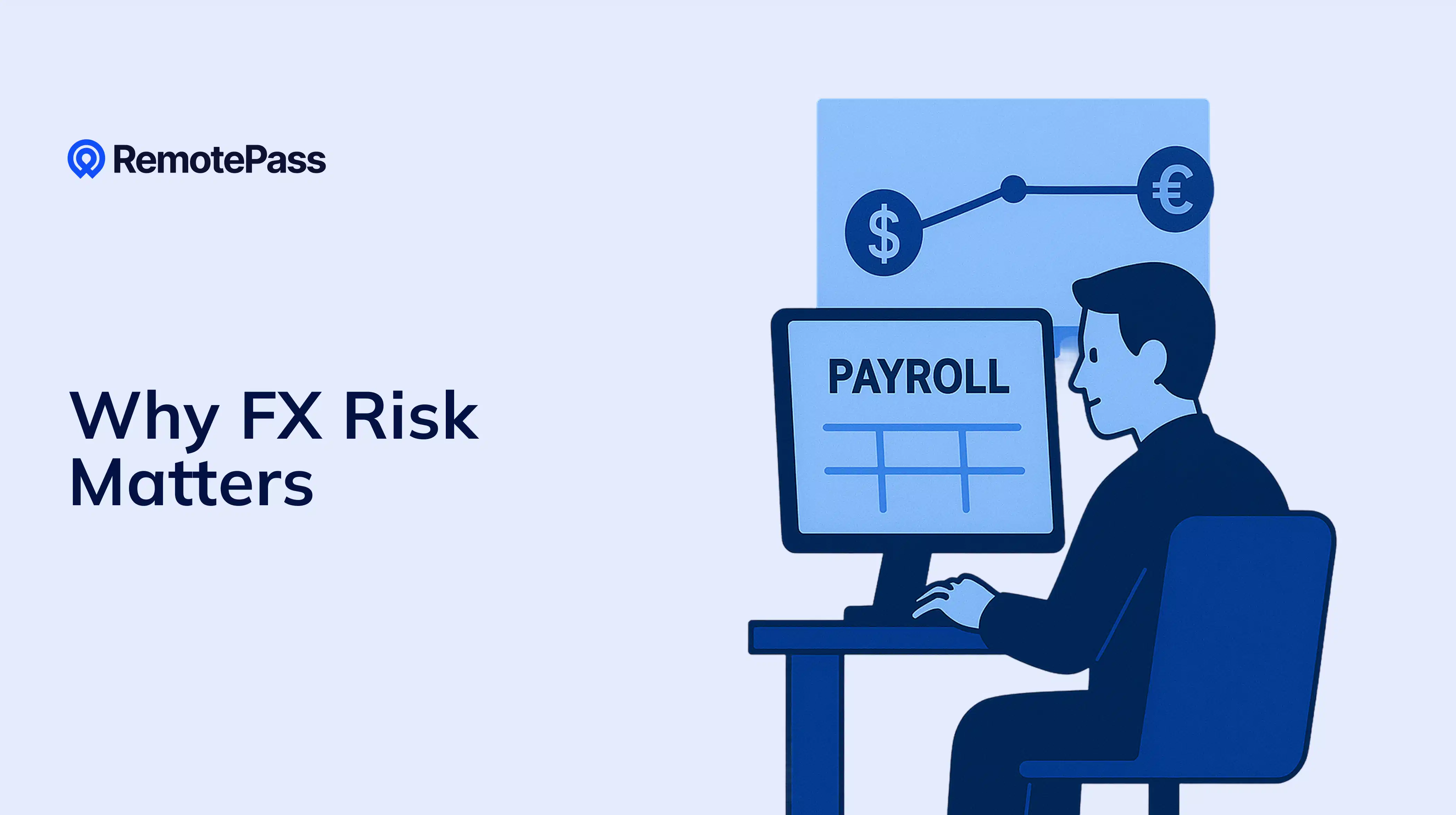
Delays in paying salaries, underpaid taxes, and shortfalls in employer contributions often trace back to unhedged currency swings. Even small shifts can throw off carefully planned budgets.
Take a simple example: you’re running payroll for a U.S. team from a UAE headquarters with a €100,000 monthly budget. Three consecutive weekly rate bumps of just 0.5% ahead of payday force you to find an extra €1,500 to keep payroll whole. Extend that across twelve months, multiple teams, and different currencies, and the compounding effect can wreck financial forecasts.
Without a plan, finance teams start guessing instead of managing risk and employees feel the impact first when payroll slips.
What Causes FX Risk in Payroll?
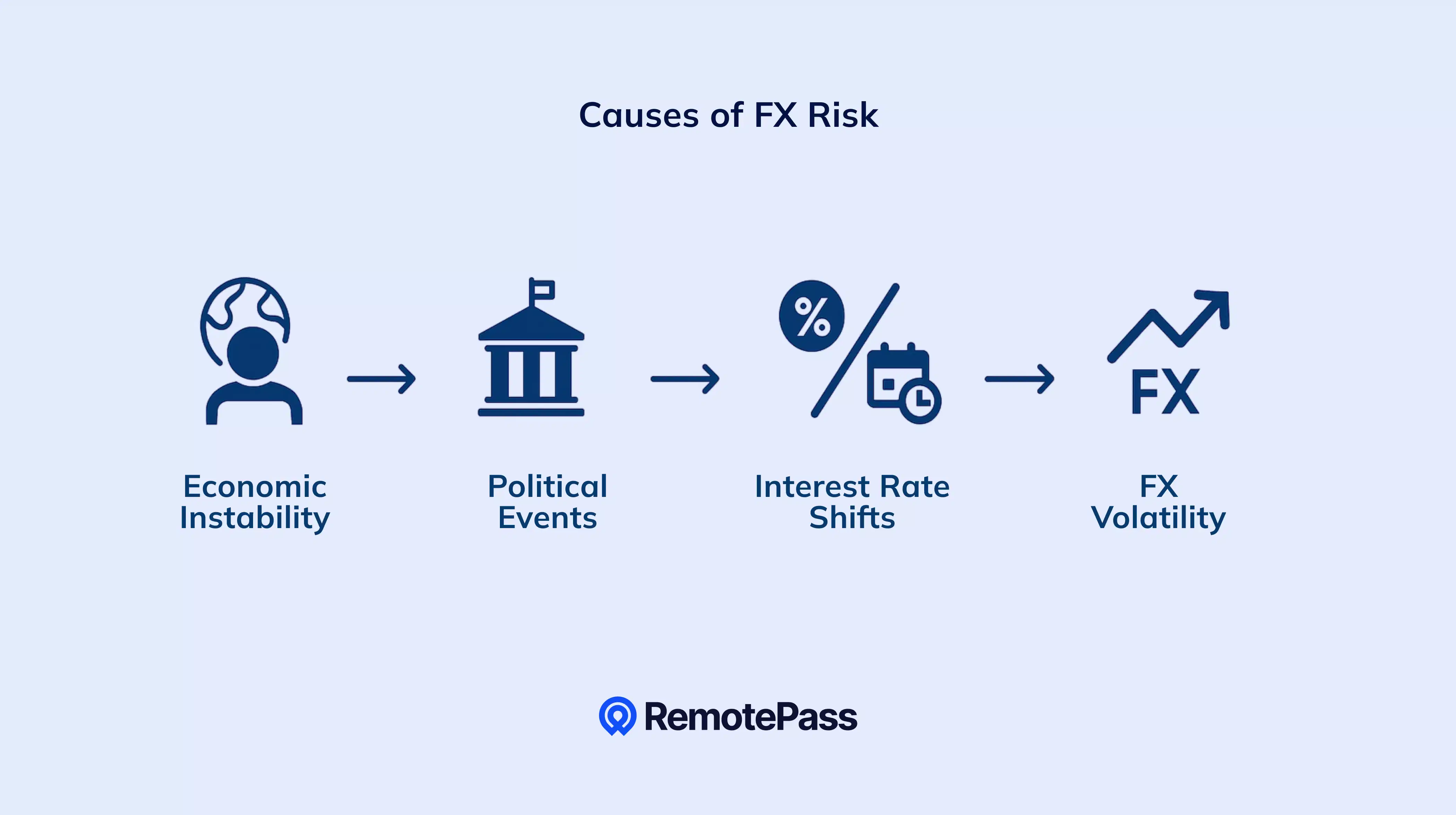
Currency values swing for reasons finance leaders can’t control such as economic instability, trade tensions, regulatory changes, and shifting interest rates all push exchange rates up or down.
But when you’re running payroll across multiple countries, these market forces collide with operational realities:
- Timing mismatches: Payroll approvals, funding, and payouts often cross time zones. In places like DIFC or AGM UAE Free Zones even a few hours’ delay can collide with an overnight rate hike, leaving finance teams scrambling to plug gaps.,
- Local currency exposure: Paying workers in local currencies protects them from conversion headaches, but it leaves the employer carrying the FX risk. Add contractor markups on self-converted payments, and costs creep higher while employee trust erodes.
- Complex payment systems: Many companies juggle multiple bank accounts and tax filings across countries. While this simplifies local compliance it also means FX fluctuations hit at different points in the payroll chain, turning a well-planned process into a moving target.
Each factor compounds the next. The result? Payroll budgets drift, forecasts lose accuracy and finance teams end up explaining shortfalls instead of preventing them.
How Do Global Finance Teams Deal With FX Volatility?
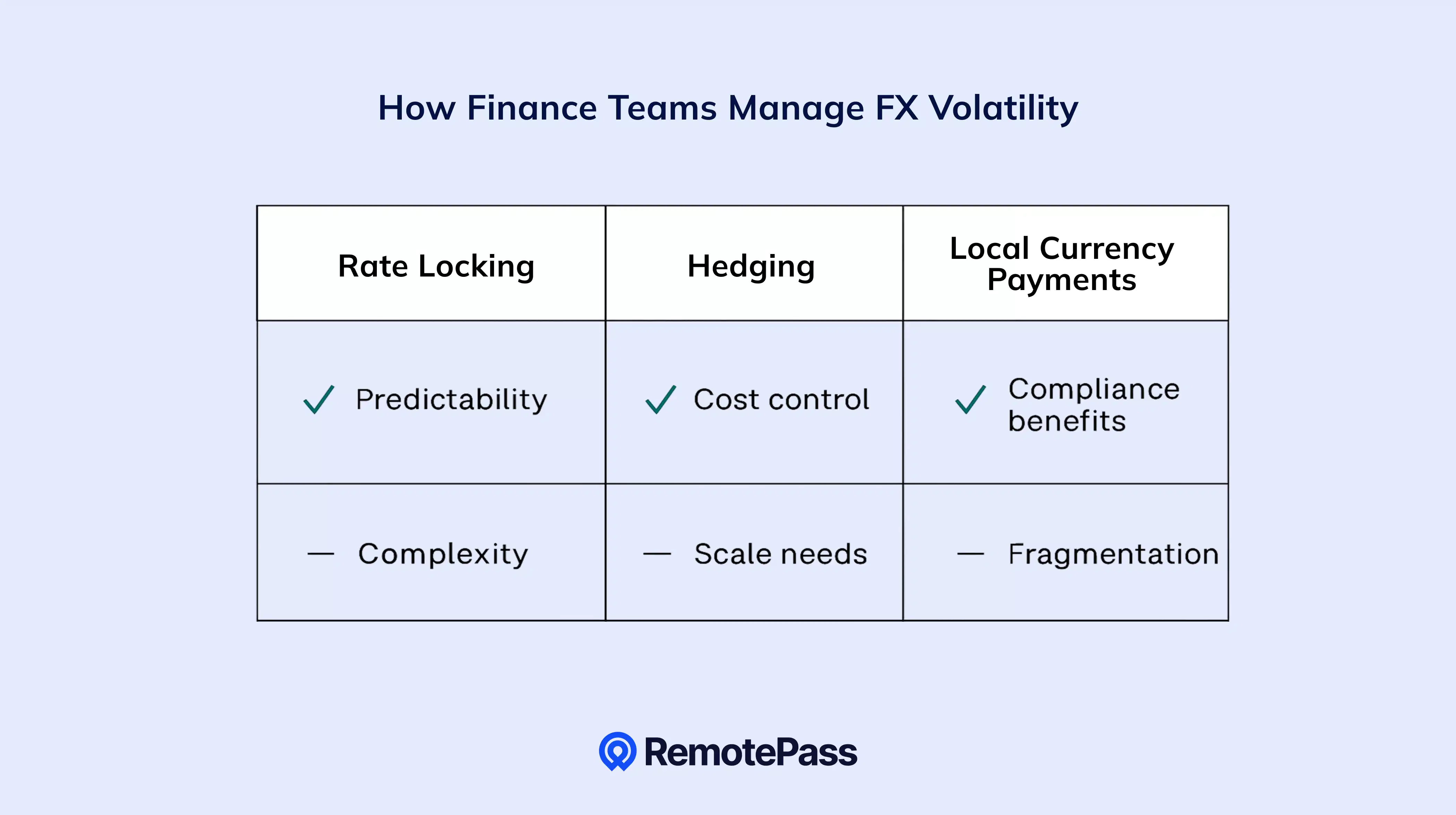
Finance leaders use a mix of tools and tactics to keep payroll predictable when currencies swing:
- Rate Locking
Short-term fixed-rate agreements with payroll platforms or banks let companies lock in exchange rates ahead of each payroll run. For weekly or monthly payouts, this removes the guessing game.
Even if the FX market shifts slightly, you know exactly what you’ll be paying out each cycle, which makes cash flow planning much easier.
- Hedging (for larger enterprises)
Enterprises with larger payroll exposure often use forward contracts or FX options to secure rates months in advance.These options allow enterprises to secure stable rates for future payments, minimising exposure to sudden volatility in global markets.
This approach isn’t always practical for smaller businesses as hedging requires financial instruments and banking relationships many startups don’t have. But at scale, it stabilizes costs and shields budgets from market shocks.
- Paying in Local Currency (vs USD/EUR)
Funding salaries directly in workers’ home currencies avoids unexpected deductions when employees self-convert funds. It also reduces payroll disputes and improves retention since workers see the full amount they expect. Combining local payouts with rate locking gives finance teams even tighter control.
- Working with a Multi-Currency Payroll Provider like RemotePass
Managing FX exposure and local payouts internally means dealing with multiple banks, shifting rates, and ever-changing compliance rules. It’s a drain on time and leaves room for costly mistakes.
A global EOR like RemotePass solves those issues, handling conversions, securing competitive rates, and paying employees in their local currency.
Beyond the payouts, RemotePass also assumes the legal and compliance burden in each country. This reduces risk for finance teams while eliminating the operational sprawl of managing separate systems for payroll, FX, and compliance. The result: fewer errors, lower costs, and a payroll process that scales with the business instead of holding it back.
Common FX Mitigation Strategies and Their Pros and Cons
How RemotePass Helps You Manage FX Risk
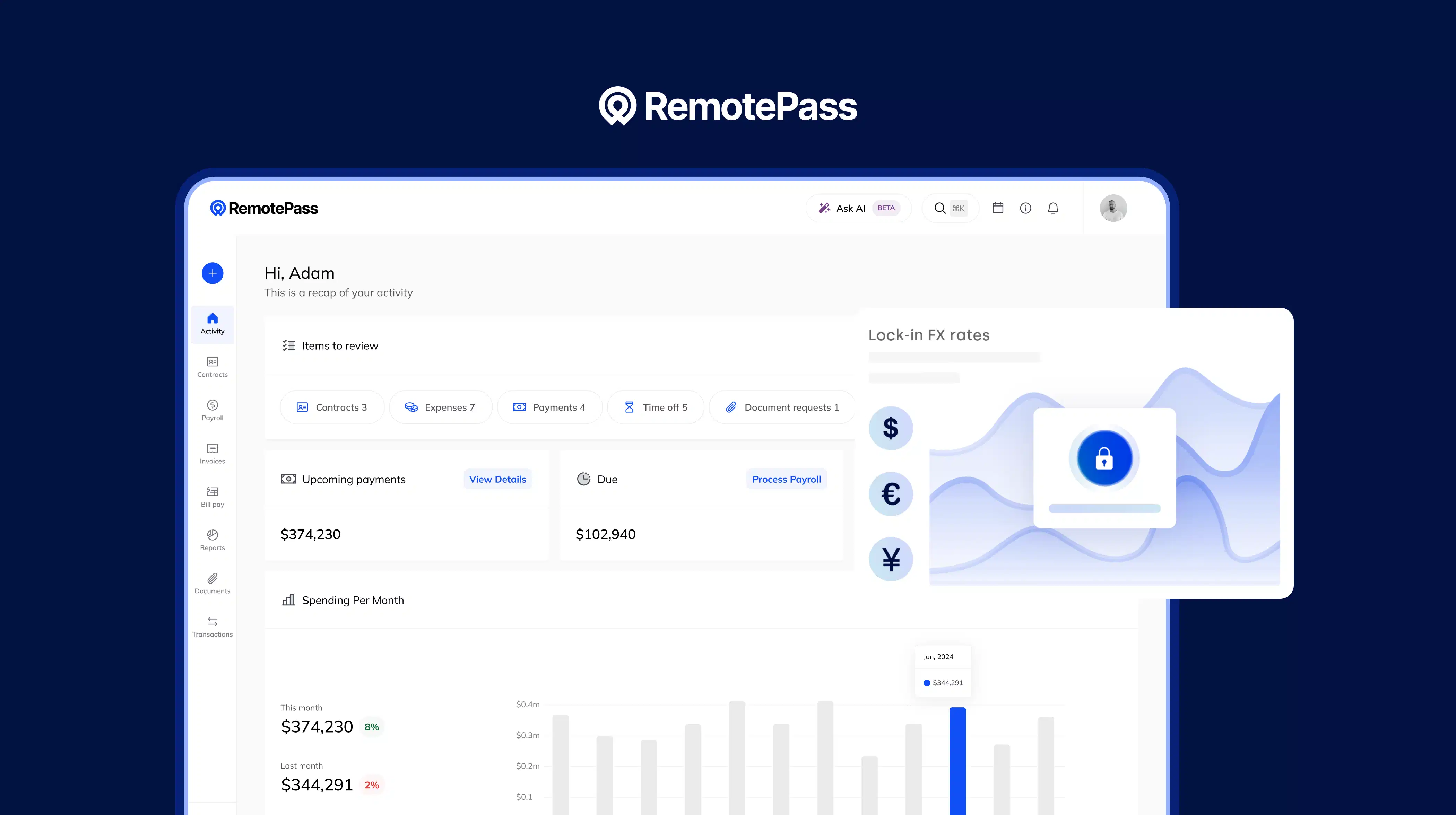
In the words of Omobolanle Winnifred Ola, Human Resource Business Partner at MoniePoint Inc, Africa’s leading financial service provider;
“With RemotePass, we can process payments on the same day if needed, which has been a game-changer. Our employees in 13 countries now have access to transparent exchange rates and more withdrawal options. We’ve eliminated the frustrations of hidden fees and long payment delays, and our finance team is no longer bogged down by managing multiple payment cycles”
MoniePoint’s experience reflects what many finance leaders want but rarely achieve: payroll that’s fast, accurate, and immune to FX chaos. Across sub-Saharan Africa, FX volatility continues to erode billions in operating costs each year. Yet MoniePoint sidesteps the problem because RemotePass locks rates, consolidates payroll operations, and ensures every employee, whether paid in USD, GBP, NGN, or AED, gets the right amount on time.
Overall, RemotePass is a platform built for finance leaders who need control. Rate-locking, local currency payouts, and automatic FX reconciliation come standard. Every exchange rate bump updates instantly across reports, keeping payroll, finance, and compliance teams aligned without extra work.
For enterprises operating across Africa, Asia, Europe, or the UAE, this accuracy matters. Even companies in the UK and US lost over 76% more to FX fluctuations in 2024 than in previous years, a number set to rise as global hiring expands. RemotePass gives you the infrastructure to stop those losses before they start.
Why Should FX Risks Matter To Your Firm?
Every month of unmanaged FX volatility chips away at budgets, delays payroll, and erodes employee trust. Finance teams stuck juggling manual rate locks and short-term fixes lose the bandwidth to focus on forecasting, strategy, and growth. If this sounds familiar, it’s time to rethink your payroll infrastructure and that’s where RemotePass comes in.
Final Words
FX volatility is real but manageable with RemotePass. We are trusted by global enterprises to control FX Volatility and handle the many twists and details that come with multi-currency payrolls.
RemotePass gives global enterprises the tools to:
- Lock exchange rates in advance
- Pay teams in 90+ local currencies
- Consolidate payroll, compliance, and reporting in one platform
The result: predictable costs, happier employees, and finance teams free to focus on strategy instead of firefighting.
Book a demo to learn how RemotePass can help you lock rates, pay in local currencies, and manage global payroll with confidence.
FAQs
Can I pay all contractors in USD to avoid FX?
No. FX risk affects every currency. Paying everyone in USD simply shifts the volatility onto your contractors and when rates rise against their local currency, they absorb the loss. That creates churn risk as top contractors leave for employers who pay in local currency. A better approach is to agree on the payment currency upfront and lock in the rate before payroll. RemotePass’s Contractor of Record (CoR) service helps you manage this across markets.What happens if I don’t lock rates before payroll?
You expose your company to unpredictable losses. Rate swings after payroll funding can also trigger local compliance issues, especially in regions like DIFC and ADGM where underpayment can have legal consequences.RemotePass’s Employee of Record (EOR) guide simplifies the journey for users who don’t want to deal with compliance, payroll and rate locking themselves.
How do I calculate how much I’ll need to fund payroll if currencies are fluctuating?
With RemotePass, you can rate-lock seven days before payment is due, and sort fund payroll without panicking. Calculations and conversions can also be done on the platform.
What currencies does RemotePass support for local payouts?
90+ currencies across 150 countries are currently supported. We also support payouts in crypto, stablecoins or any other option your firm might be looking to explore.
Looking to explore local payroll options? Click here.
What’s the difference between rate locking and hedging?
Rate-lock refers to agreeing on or purchasing at a certain rate with FX providers or banks over a short period of time, while hedging is a forward contract or agreement made with any party to sell or buy currency ahead of time (either short or long). Most SMBs start with rate-locking for its speed and predictability.

.svg)








.svg)































.svg)








